牛津译林版八年级上册 Unit 4 Do it y ourself Grammar课件(共28张PPT)
文档属性
| 名称 | 牛津译林版八年级上册 Unit 4 Do it y ourself Grammar课件(共28张PPT) | 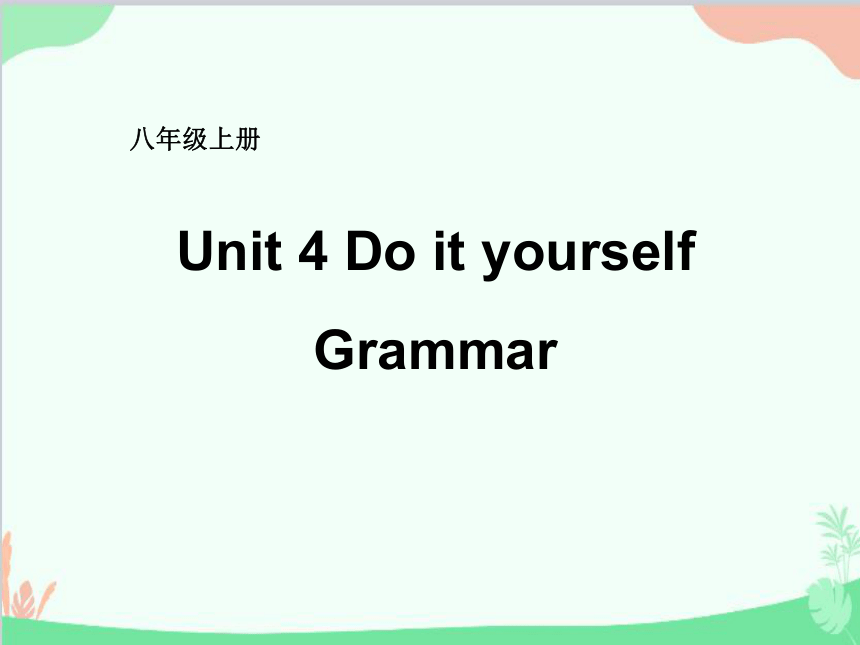 | |
| 格式 | ppt | ||
| 文件大小 | 2.7MB | ||
| 资源类型 | 教案 | ||
| 版本资源 | 牛津译林版 | ||
| 科目 | 英语 | ||
| 更新时间 | 2023-01-13 16:57:48 | ||
图片预览



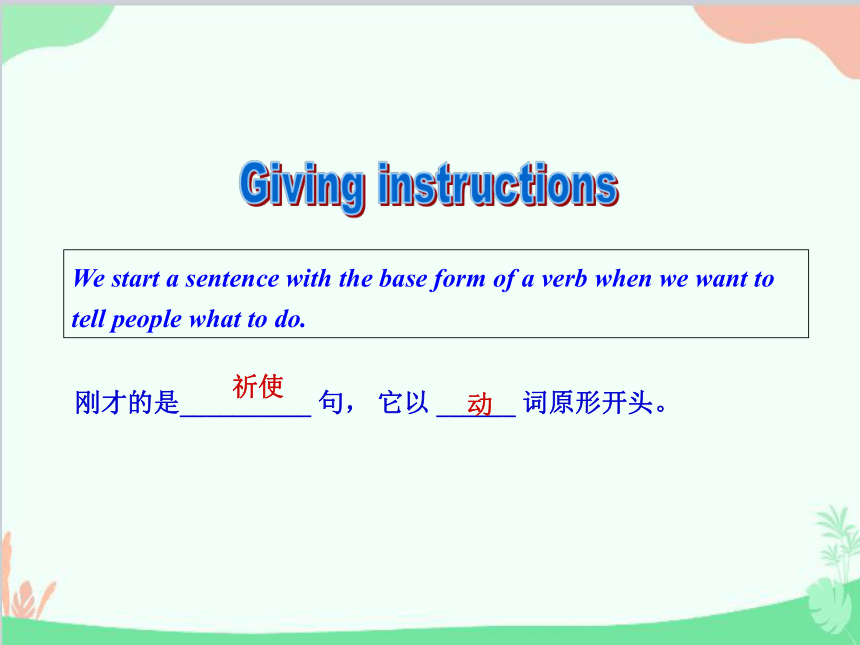
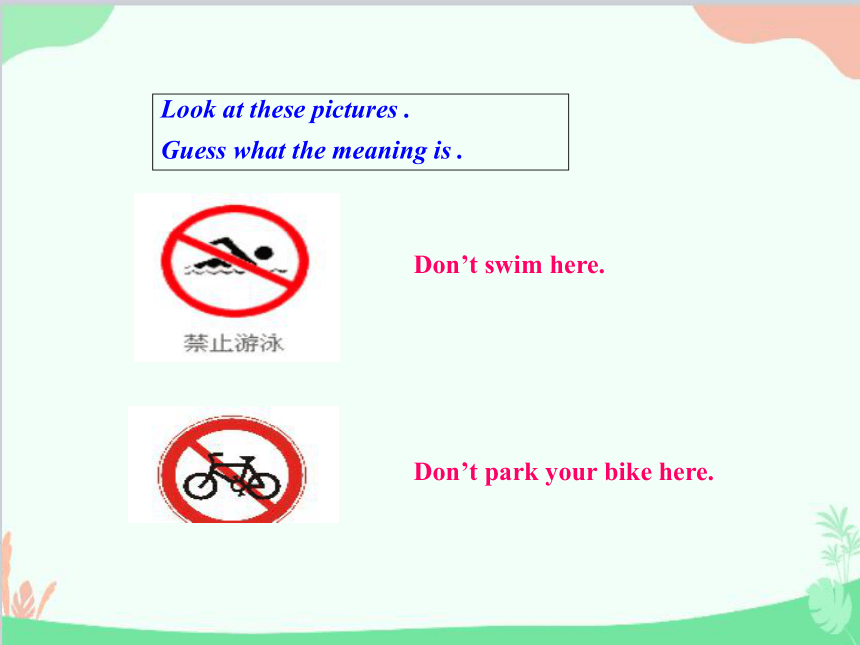
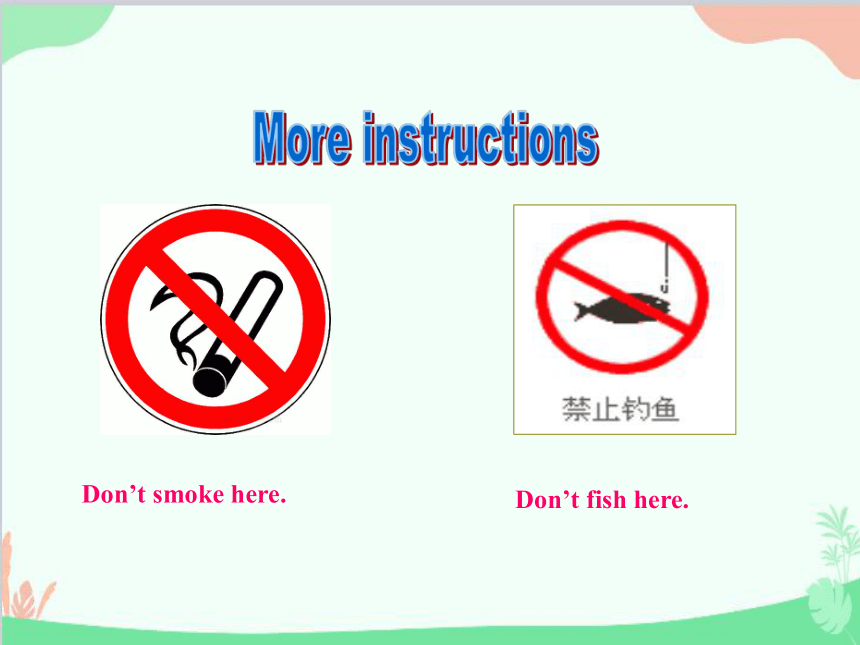

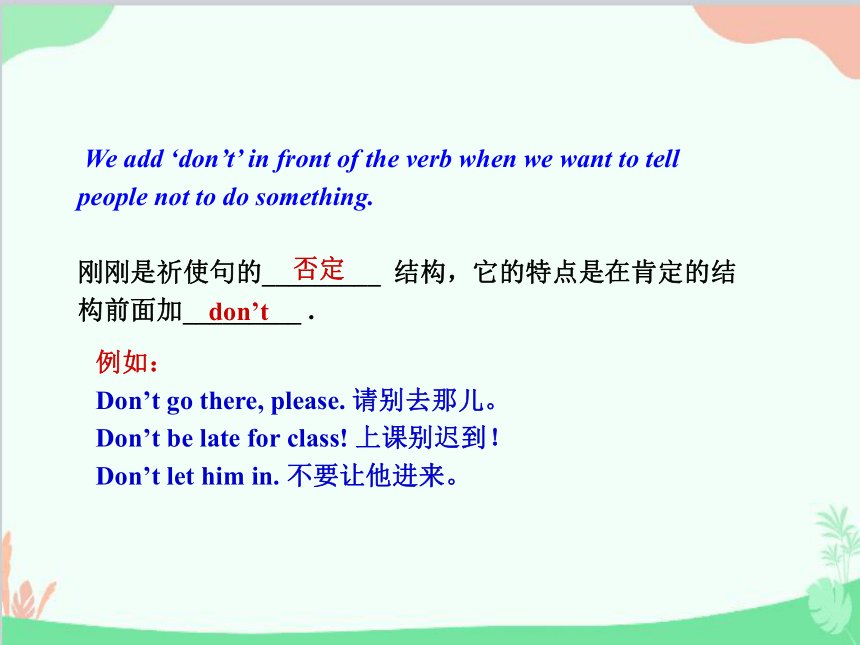

文档简介
(共28张PPT)
Unit 4 Do it yourself
Grammar
八年级上册
教学目标
1. 学会运用祈使句表达指令。
包括: 1) 祈使句的肯定结构
2) 祈使句的否定结构
2. 学会用should(not)和had better (not)来提出建议。
Play a game .
1. Stand up .
2. Sit down .
3. Put up your hands .
4. Jump twice .
6. Go back to your seats , please.
Please 的作用:以使语气更加缓和或客气。放在句前或句后均可以。
5. Touch your nose .
We start a sentence with the base form of a verb when we want to tell people what to do.
刚才的是__________ 句, 它以 ______ 词原形开头。
祈使
动
Don’t swim here.
Don’t park your bike here.
Look at these pictures .
Guess what the meaning is .
Don’t smoke here.
Don’t fish here.
Don’t make any noise.
例如: Don’t go there, please. 请别去那儿。
Don’t be late for class! 上课别迟到!
Don’t let him in. 不要让他进来。
We add ‘don’t’ in front of the verb when we want to tell people not to do something.
刚刚是祈使句的_________ 结构,它的特点是在肯定的结构前面加_________ .
否定
don’t
Activity : How to make cards
Now let’s make cards by ourselves .
First, cut …,
Then, write …,
Next , draw ….,
Finally, look at …
How to make cards
1. Cut out pieces of card with a pair of scissors.
2. Write some words or a sentence on each card.
How to make cards
3. Draw a picture about the words or sentence on the other side of the card.
4. Look at the picture and try to say what is on the other side.
Please don’t give up. Keep trying and you will find you can remember things better.
Watch the following sentences
1. When you make cards ,you should be careful with scissors because they are dangerous.
You should not play with scissors
2. You had better be careful with scissors.
You had better not play with scissors .
1. Please know a little about DIY.
You should know a little about DIY.
We use ‘should’ and ‘had better’ when giving advice
and telling people what is the best or right thing to do.
You had better know a little about DIY.
2. Please put in a brighter light in the room.
You should put in a brighter light in the room.
We use ‘should’ and ‘had better’ when giving advice
and telling people what is the best or right thing
to do.
You had better put in a brighter light in the room.
3. Don’t paint the whole room blue.
You should not/shouldn’t paint the whole room blue.
You had better not paint the whole room blue.
We use ‘should’ and ‘had better’ when giving advice
and telling people what is the best or right thing
to do.
当我们给他人提建议时,可以用had better和should,表示“最好”或“应该”做某事, had better的语气比should强一些。
You had better put up (张贴) a picture on the wall.
You should exercise more.
Notice :
You’d better go to hospital at once.
你最好立即去医院看病。 Tom had better go there today.
汤姆最好今天去那儿。
had better (常简略为’d better),是一固定词组,后面必须跟动词原形,没有人称和数的变化。构成:had better do sth. 句型。
had better 的否定式是将not直接放在had better的后面。
You had better not miss the last bus.
你最好不要错过末班公共汽车。
Your father should stop smoking .
You should stop smoking.
你应该戒烟。
should 后面也要跟动词原形,且没有人称和数的变化。
should 的否定式是should not/shouldn’t。
You shouldn’t drink and drive.
你不应该喝酒后开车。
1. 当我们向他人发出命令、提出要求或建议时,常使用祈使句。其主语通常不明确表示出来。其否定形式是在动词原形前加do not/don’t。为了表示客气和礼貌,可以加上please。
2. 当我们给他人提建议时,可以用had better和should,表示“最好”或“应该”做某事。否定形式是had better not和should not/shouldn’t。
Practice 句型转换。
1. The teachers often tell the students not to
be careless. (改为祈使句) ________ careless, please. 2. Please sit next to Nancy. (改为否定句) ________ next to Nancy.
Don't be
Don't sit
III. 完成句子。
1. 你应该在南京换火车。
__________ change trains at Nanjing.
2. 你最好在下雨前回家。
___________________ before the rain
starts.
3. 现在你最好别打棒球了。
_____________________ baseball now.
4. 不要把金鱼放在阳光下。
_________ the goldfish in the sun.
You should
You'd better go home
You had better not play
Don’t put
Phrases and sentences
Put up a picture on the wall .
Don’t paint the cat .
Please fix the shelf for me .
Don’t touch the wet paint , please .
You should know a little about DIY .
You shouldn’t put so many books on the shelf .
Your watch is broken . You had better buy a new one .
You had better not be late for school .
9. Don’t write anything on the other side of the card .
→ on the other side of ….
10. give up 放弃
1. Review the Grammar and make
some sentences with should (not)
and had better (not).
2. Finish the Exercises in the workbook.
Homework
Unit 4 Do it yourself
Grammar
八年级上册
教学目标
1. 学会运用祈使句表达指令。
包括: 1) 祈使句的肯定结构
2) 祈使句的否定结构
2. 学会用should(not)和had better (not)来提出建议。
Play a game .
1. Stand up .
2. Sit down .
3. Put up your hands .
4. Jump twice .
6. Go back to your seats , please.
Please 的作用:以使语气更加缓和或客气。放在句前或句后均可以。
5. Touch your nose .
We start a sentence with the base form of a verb when we want to tell people what to do.
刚才的是__________ 句, 它以 ______ 词原形开头。
祈使
动
Don’t swim here.
Don’t park your bike here.
Look at these pictures .
Guess what the meaning is .
Don’t smoke here.
Don’t fish here.
Don’t make any noise.
例如: Don’t go there, please. 请别去那儿。
Don’t be late for class! 上课别迟到!
Don’t let him in. 不要让他进来。
We add ‘don’t’ in front of the verb when we want to tell people not to do something.
刚刚是祈使句的_________ 结构,它的特点是在肯定的结构前面加_________ .
否定
don’t
Activity : How to make cards
Now let’s make cards by ourselves .
First, cut …,
Then, write …,
Next , draw ….,
Finally, look at …
How to make cards
1. Cut out pieces of card with a pair of scissors.
2. Write some words or a sentence on each card.
How to make cards
3. Draw a picture about the words or sentence on the other side of the card.
4. Look at the picture and try to say what is on the other side.
Please don’t give up. Keep trying and you will find you can remember things better.
Watch the following sentences
1. When you make cards ,you should be careful with scissors because they are dangerous.
You should not play with scissors
2. You had better be careful with scissors.
You had better not play with scissors .
1. Please know a little about DIY.
You should know a little about DIY.
We use ‘should’ and ‘had better’ when giving advice
and telling people what is the best or right thing to do.
You had better know a little about DIY.
2. Please put in a brighter light in the room.
You should put in a brighter light in the room.
We use ‘should’ and ‘had better’ when giving advice
and telling people what is the best or right thing
to do.
You had better put in a brighter light in the room.
3. Don’t paint the whole room blue.
You should not/shouldn’t paint the whole room blue.
You had better not paint the whole room blue.
We use ‘should’ and ‘had better’ when giving advice
and telling people what is the best or right thing
to do.
当我们给他人提建议时,可以用had better和should,表示“最好”或“应该”做某事, had better的语气比should强一些。
You had better put up (张贴) a picture on the wall.
You should exercise more.
Notice :
You’d better go to hospital at once.
你最好立即去医院看病。 Tom had better go there today.
汤姆最好今天去那儿。
had better (常简略为’d better),是一固定词组,后面必须跟动词原形,没有人称和数的变化。构成:had better do sth. 句型。
had better 的否定式是将not直接放在had better的后面。
You had better not miss the last bus.
你最好不要错过末班公共汽车。
Your father should stop smoking .
You should stop smoking.
你应该戒烟。
should 后面也要跟动词原形,且没有人称和数的变化。
should 的否定式是should not/shouldn’t。
You shouldn’t drink and drive.
你不应该喝酒后开车。
1. 当我们向他人发出命令、提出要求或建议时,常使用祈使句。其主语通常不明确表示出来。其否定形式是在动词原形前加do not/don’t。为了表示客气和礼貌,可以加上please。
2. 当我们给他人提建议时,可以用had better和should,表示“最好”或“应该”做某事。否定形式是had better not和should not/shouldn’t。
Practice 句型转换。
1. The teachers often tell the students not to
be careless. (改为祈使句) ________ careless, please. 2. Please sit next to Nancy. (改为否定句) ________ next to Nancy.
Don't be
Don't sit
III. 完成句子。
1. 你应该在南京换火车。
__________ change trains at Nanjing.
2. 你最好在下雨前回家。
___________________ before the rain
starts.
3. 现在你最好别打棒球了。
_____________________ baseball now.
4. 不要把金鱼放在阳光下。
_________ the goldfish in the sun.
You should
You'd better go home
You had better not play
Don’t put
Phrases and sentences
Put up a picture on the wall .
Don’t paint the cat .
Please fix the shelf for me .
Don’t touch the wet paint , please .
You should know a little about DIY .
You shouldn’t put so many books on the shelf .
Your watch is broken . You had better buy a new one .
You had better not be late for school .
9. Don’t write anything on the other side of the card .
→ on the other side of ….
10. give up 放弃
1. Review the Grammar and make
some sentences with should (not)
and had better (not).
2. Finish the Exercises in the workbook.
Homework
